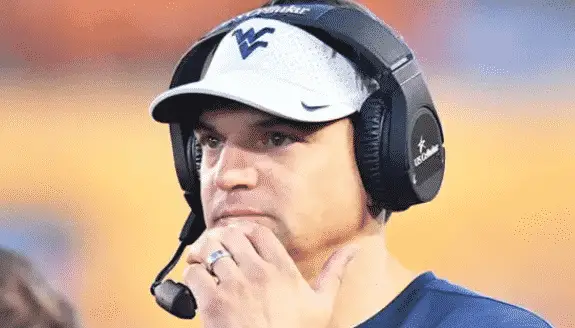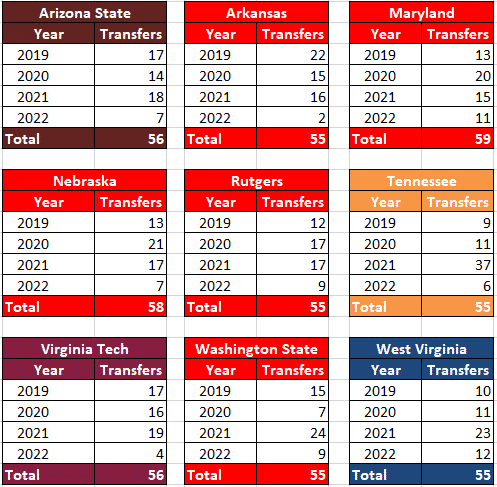
In the first part of this series, we identified a few potential causes for the volume of transfers over the past 3+ years including coaching changes and lack of playing time/losing a position battle. These are common reasons for players to transfer across all of collegiate athletics. However, these reasons don’t explain some of the more recent transfers. The most concerning, in my opinion, being young players that a shot at earning a job behind an upper classman (e.g. James Thomas and Kerry Martin). As stated in the previous article, a big reason behind these transfers may be the NCAA’s new “free transfer” year rule that allows players to transfer once without sitting out to any school they choose.
Since 2019, there have been 11 teams with 55 plus transfers, 9 of which are Power 5 schools. This list includes (in order from most transfers to least) Tennessee, Maryland, Nebraska, Arizona State, Virginia Tech, West Virginia, Arkansas, Rutgers, and Washington State.

The common theme between most of these schools (with the exception being Arizona State) is they have not performed particularly well over most of this time period, and they have experienced a coaching change. The yellow highlighting in the table below indicates the first year of a head coach at the school. The red highlighting in the table below indicates when a coach was fired at the end of this time period.

So what does this tell us? Well first, the two years from when a coach is hired have a higher transfer rate with an average of 15 players transferring per year during this initial two-year period. However, there is also a strong correlation between a coach being fired and the transfer rate; an average of 21 players transfer from schools the year prior to a coach being let go. As the saying goes, when there’s smoke there’s fire.
WVU can fit into either of these buckets. WVU’s highest transfer amount coincides with Neal Brown’s 2nd full season with the program (the 2020-2021 period in the tables above). 4 of the 7 other teams that had new head coaches in the tables above have had their highest transfer rates during the first full season for the new head coach. The exceptions are Arizona State (3rd year), Nebraska (2nd year), and Tennessee (3rd year). While WVU’s spike could be interpreted as a warning sign that Neal Brown’s program has not been successful, I think it is still too early to say that for sure. I think it is more likely that the large transfer rate is due to Brown’s novelty at WVU, but another big transfer year (15+ transfers) plus another let down of a season (5 wins or else) could lead to an unfavorable situation.
It is important to note that West Virginia actually sports the 3rd highest winning percentage (54%) of the teams that have the highest transfer rate over the past 4 years, behind only Washington State (60%) and Arizona State (60%). So what else could be putting WVU at a disadvantage? The college football landscape is changing. There is much more freedom of mobility for all players. There are ways for players to compensate off their name, image, and likeness. And there is uncertainty behind conference alignment and prestige. West Virginia is in a poor spot in all of these aspects. In terms of revenue, West Virginia received $19M, which ranked last (#65)[i] among Power 5 teams in the 2019-2020 fiscal year. For comparison, Pitt ranked #55 with a revenue of $37.9M, nearly double West Virginia’s. The nearest Big 12 member? Kansas coming in at #51 with a revenue of $40.6M. And all the schools with the highest transfer rates? They all but Rutgers have revenues that at least double WVU’s. To make matters worse, the top 6 schools on this list all brought in at least $100M in revenue during this period, which is 5 times the amount WVU brought in during this period. This lack of revenue can mean outdated facilities, less money to retain quality coaches, and less marketing and promotion.
Needless to say, WVU is an outlier when it comes to Power 5 teams. In fact, it lines up more favorably revenue wise to top Group of 5 teams. UCF, Colorado State, Brigham Young, Temple, SMU, Memphis, Boise State, and USF all bring in more revenue that WVU. Future Big 12 schools, Houston and Cincinnati, brought in similar revenue: $18M and $15M respectively. Part of this is due to WVU’s location. West Virginia is the smallest state by population with a Power 5 team with the next closest state in size being Nebraska with about 150,000 more people. Morgantown, while having the reputation for its nightlife, is one of the 4th lowest populated city with a Power 5 team. The three smaller cities are Ole Miss, Mississippi State, and Clemson. It’s hard to bring in money when the fan base is among the smallest in the country. Additionally, wealthy and supportive donors are big for a school’s athletic department’s budget, and outside of Ken Kendrick, there are not a lot of deep pocketbooks in WVU’s alumni network.
Due to the low population of West Virginia, WVU does not have a very fertile recruiting ground. Compared to the similarly sized states with Power 5 conferences, West Virginia produces consistently much less talent than Mississippi and Nebraska. In fact, West Virginia has only produced more 3+ star prospects than Nebraska once in the past 5 years.

All this is not to say that West Virginia is a bad place to be, or that we should throw in the towel. However, running a successful program at WVU is HARD. Not only is it hard to get players in at WVU, but more recently it has been hard to keep them here. Without big donors, WVU will not be able to offer the NIL deals that can match other programs. Without a large, talented pool of home-grown talent, it can be hard to keep players at WVU who have no attachment to here. Of course, many who come here from other areas of the country grow to love the state, but West Virginia can be an acquired taste, which isn’t meant for some who come from more populous or urban areas of the country; there’s no beaches, high-end night clubs, celebrities, or a wide variety of entertainment options. WVU got to this place by tapping into recruiting grounds where they have strong connections and relationships, developing that talent, and consistently winning. The changing environment of college football is making that harder. In order to survive, the climb needs to hasten, and we need to start winning again. Because as the saying goes, “winning cures everything”.
Make sure to check out Brandon on The Voice of Motown Podcast. Subscribe and listen below:
[i] https://ope.ed.gov/athletics/#/





